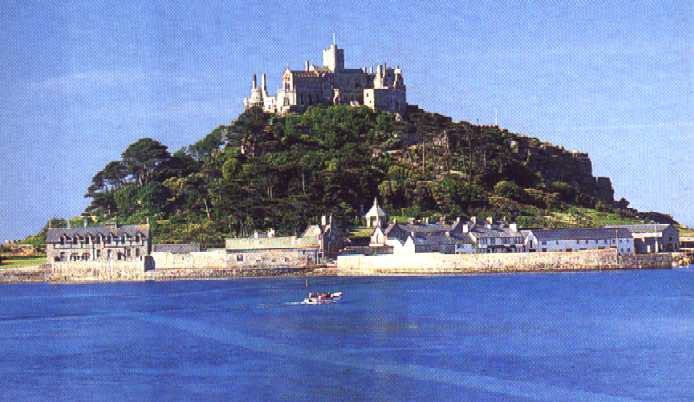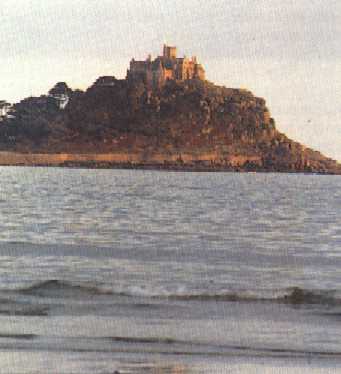|
|
|

St. Michael's Mount

Various giants are said to have lived in the county, including Cormoran who supposedly built St. Michael's Mount.
Cormoran decided to live on 'the white rock in the wood' when it was still six miles inland and he needed a high lookout point above the trees. He chose his building materials carefully, only granite would be suitable, and his wife would build it.
Cormoran forced his wife, Cormelian, to collect huge granite boulders from Penwith moors and carry them back in her leather apron. One day, rather than walking all the way to the moors, she picked up a piece of greenstone nearby and tried to sneak it past the snoozing Cormoran. However he awoke, saw what she was carrying and kicked her forcefully. She stumbled, the apron strings snapped and the greenstone fell to the ground. This stone became Chapel rock, because a chapel was built on it in early Christianity, which can still be seen today.
Cormelian was killed by a hammer blow from a hammer thrown by the giant who lived on Trencrom Hill (Trecobben, possibly Cormoran's brother). Both giants were grief stricken and their upset caused a storm at sea. Then the two giants lifted Chapel Rock and buried her underneath it.
Cormoran was eventually killed by Jack, a farmer's son, after the local people got fed up with the giant stealing their cattle. A reward was offered and Jack took up the offer. He dug a huge pit near Morvah and covered it with straw. The giant rushed down the hill when Jack blew his horn and fell into the pit. Jack then killed him with a blow from his pickaxe and buried him in the pit. Above the grave is a large stone called Giants Grave.


The Chapel on The Mount

The Mount was once surrounded by dry land, maybe slightly boggy marsh on one side, and forests. Now at high tide it is an island and the remains of fossilised trees have been discovered in Mount's Bay.
The Mount has long been regarded as being a sacred place. In 495 AD a group of local fishermen are said to have seen the Archangel Michael atop a rocky ledge, thus starting the Mount's importance as a shrine.
A Benedictine Monastery was founded there in 1044 and the Abbot's kitchen is still well preserved and stands apart from the 14th century castle that incorporated the rest of the Monastery buildings.
A church built on the rock, but demolished in 1275 by an earthquake, had mysterious healing abilities. When it was being rebuilt, the skeleton of an 8ft tall man was discovered and the 9ft-tomb cut in the rock is sited near the Chapel's altar.
The main Ley Line in England, the St. Michael's Line, runs from here and passes through several other St. Michael churches before ending in Suffolk.
